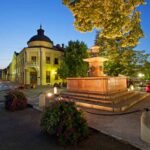Looking for the very best day trips from Zadar, Croatia?
My husband was born in Zadar, and we have a house just outside the city where we spend several months a year. So, I know a lot about this beautiful area – including some amazing spots that even some locals don’t know about.

We’ve explored all around Zadar and found some fantastic places that are perfect for a day out. In this guide, I’ll share these hidden gems with you. Whether you’re into quiet beaches, old villages, or tasty local food, there’s something for everyone.
Most of these places are just a short drive away, so you don’t have to spend all day traveling.
How to organize a day trip from Zadar
You’ve got six main ways to get around: renting a car, public buses, guided tours, boats and ferries, or private transfer. Let’s look at the pros and cons of each option.
Car Rental
This gives you the freedom to go wherever you want, whenever you want. But heads up, I only recommend renting a car if you’re pretty experienced behind the wheel. Driving around Zadar, especially in the summer, can be a bit of a headache.
If you’re not in the know about those little parking spots where locals park for free, you might end up paying a hefty 20 euros just for parking, and that’s no fun.
Btw, last summer I parked in one of those ‘local’ spots, thinking I was all set as police usually ignore it if they see local plates. Not my luck, though – I ended up with a 35-euro parking ticket, and you can’t pay these on the spot. You have to go to a bank or post office.
Trying to find a parking spot in Zadar during summer is like trying to find a needle in a haystack, no matter what time it is. So, if you’re thinking about hiring a car, just be ready for these kinds of things.
Public Buses
There are a variety of day trips you can do from Zadar using ‘public transport’.
Buses are the most affordable way to travel to places like Šibenik, Split, or Nin, but the schedules can be a bit limited and the trip will take longer than other options.
So, if you’re planning a day out and want to save some cash, just be prepared for a slower pace.
Guided Tours
These are great for when you want everything planned out for you. You’ll learn heaps, especially on trips focused on culture or history, since you’ll have a local guide to show you the ropes. These tours, whether private or in small groups, are an efficient way to explore.
The beauty of guided day trips is that they often include multiple stops, letting you see and do more in one go.
There are some places around Zadar that you just can’t get to without a car and for those spots, day tours are your go-to option if you’re not driving yourself.
Boats and Ferries
For island destinations like Ugljan Island, Dugi Otok, or the Kornati Islands, taking a ferry or a boat is necessary. Check with local ferry services like Jadrolinija for schedules and tickets. Some guided tours to islands also include boat transportation.
Private Transfers
For a more comfortable and personalized experience, you can book a private transfer. This is a more expensive option but offers convenience, especially for less accessible locations or if you’re traveling in a group.
Biking
As a final option, for those nearby destinations or if you’re feeling adventurous, you can rent a bike. Zadar and its surrounding areas are laced with some scenic bike routes, perfect for day trips.
14 Best Day Trips From Zadar
Zrmanja Canyon & Rafting
If you’re in Zadar you can’t miss the Zrmanja Canyon rafting experience.

The trip begins in Kastel Zegarski, a quaint village about an hour from Zadar. Here, the Zrmanja River, with its crystal-clear waters and untouched surroundings, awaits to take you on a thrilling ride. Known for its contrasting scenery of white rocks and lush greenery, the river flows through the heart of the canyon, creating a spectacular setting for your adventure.
The great thing about Zrmanja rafting is that it’s suitable for everyone. Whether you’re a seasoned rafter or a complete newbie, the river caters to all levels. Even kids as young as six can safely enjoy the rafting experience, making it a fantastic option for a family day out.
The rafting trip covers about 14.5 kilometers and usually lasts between 2.5 to 3 hours. You’ll navigate through Grade 2 rapids, which might occasionally reach Grade 3. Don’t worry if that friendly even for beginners. Along the way, you’ll encounter moments of serene calmness and sudden rushes of excitement as you hit the rapids. It’s an exhilarating balance that keeps the journey interesting.
Before you set off, you’ll be kitted out with all the necessary gear – helmets, life jackets, and neoprene suits. The guides, who are registered with the Croatian mountain rescue service, ensure you’re well-informed with a safety briefing. Their top priority is to make your adventure both fun and safe.
To make the most of your day, pack a swimsuit, an extra T-shirt, suitable water shoes, and a towel. It’s also a good idea to bring along some snacks, water, sun protection, and a bit of cash. And don’t stress about your phone or camera; they’ll be safe in waterproof boxes provided at the start.
The adventure is reasonably priced, usually around 50 EUR for adults, with discounts available for kids. This includes all your equipment and insurance, but remember, transport to the starting point and meals are extra.
Dugi Otok (Long Island)
Reaching Dugi Otok is easy, with regular ferries from Zadar. In Sali, the largest town, you’ll find everything you need, from amenities to delicious local food.

The island is packed in summer as each village celebrates its heritage. Traditional festivities like the donkey race in Sali highlight the island’s history, where donkeys were essential in daily life.
Visit Saharun Beach, known for its clear waters and pine-fringed shoreline, perfect for a relaxing day. Telascica Nature Park is a highlight with its inviting coves, impressive cliffs, and the warm Lake Mir. This park also serves as a home to a variety of wildlife, including a group of donkeys.
Don’t miss the Veli Rat Lighthouse, the tallest in the Adriatic. Climb up for amazing views or enjoy the nearby beaches. It’s a spot that combines history with natural beauty.
For those who love the outdoors, Dugi Otok is a playground. Enjoy hiking, biking, kayaking, or simply swimming in the clear waters. The less crowded roads make for perfect cycling adventures with views of the sea.
Kornati National Park
My first visit to Kornati National Park in the late ’80s is something I’ll always remember.

On the ferry ride there, an Italian family taught me how to play rummy, which was fun. What stood out to me the most, though, was how salty the lake was on one of the islands. It was so different from the sea around it.
Kornati National Park is an archipelago in the Adriatic Sea, remarkable for its raw and rugged landscapes.
With over 140 islands and islets, it’s a haven for those who love the sea, nature, and exploring. The islands, with their cliffs diving into the deep blue, create a stunning visual.
The park is rich in biodiversity, both underwater and on land. It’s a dream spot for snorkelers and divers. On the islands, you’ll find a variety of birds and unique plant species.
Lake Vrana
It’s the largest natural lake in Croatia and a protected nature park, ideal for bird watching and fishing, especially for carp.

What makes Lake Vrana unique is the contrast in flora.
On one side of the road, you’ll see Mediterranean vegetation typical of the Adriatic coast, and on the other, a freshwater ecosystem.
This creates a remarkable visual and ecological divide. The area also has hiking and cycling paths.
Krka National Park
I don’t have to describe the waterfalls of Krka National Park.

You’re probably already familiar with them, or someone you know has been there. What I can share, though, are tips on how to see these wonders without spending too much.
The cheapest option is the ferry from Skradin. Last summer, the fare was just 10 euros, but this year it might be higher. If you’re thinking about other entry points, like near the Krka Monastery, prices are, well, tourist prices.
My sister paid 40 euros there. And I’ve heard that some routes to the waterfall can even ask for up to 100 euros. I’ll make sure to update this article with the new season’s prices as soon as they’re available.
Nin
Nin is just a short trip from Zadar and is the oldest Croatian royal town.

Here, you’ll find the Church of the Holy Cross from the 9th century and the statue of Bishop Gregory of Nin.
The town has museums like the Museum of Nin Antiquities and the Museum of Salt. When in Nin, try the “cvet soli” or flower of salt. It might be a bit pricey, but it’s probably the saltiest thing you’ll ever taste, at least it was for me.
Ugljan Island
Ugljan Island is a 25-minute boat ride from Zadar. This lush, hilly island is covered with olive groves. It’s a favorite escape for those in Zadar, especially over the weekends.

In Preko, the island’s main hub, life revolves around the harbor. For a bit of adventure, a hike up to St Michael’s church offers breathtaking views of the island and the surrounding archipelago.
Then there’s Kali, a traditional fishing village southeast of Preko. It’s a place where narrow streets twist up hills, leading you through a living history of seafaring and fishing. The harbor, crowded with fishing boats, speaks of the village’s enduring connection to the sea.
Not far from Kali, Kukljica greets visitors with its sparkling bay. This area is particularly known for its beautiful beaches.
Pag Island
Pag Island is worth visiting on a day trip. The island is connected to the mainland by a bridge.

The Town of Pag is this medieval settlement is a window into the past, with narrow streets lined with stone houses. The town is also famous for its intricate lacework, recognized by UNESCO as an Intangible Cultural Heritage of Humanity.
The Pag Lace Gallery in town is the perfect place to learn more about this traditional craft. Pag is also celebrated for its carnival, featuring traditional folk dances like the Pasko kolo.
The island is known for its delicious Pag cheese, made from sheep’s milk and often served with local white wine Žutica. The cheese’s distinct flavor is attributed to the sheep’s diet of sea-salted herbs and grass. Pag’s lamb is also a culinary highlight, considered some of the best in Croatia.
For young folks looking for nightlife, Novalja town is the go-to destination, especially the famous Zrće Beach. Known as the Croatian Ibiza, Zrće is packed with beach clubs and music festivals. During the day, the beach is a peaceful spot to relax and enjoy water sports.
The island’s rocky, barren landscape is often compared to the lunar surface, and provides a stunning backdrop for outdoor activities. Hiking, cycling, and exploring the rugged terrain are popular, as is swimming and enjoying the beaches. Pag’s beaches are known for their clear waters and are ideal for family outings.
Pag has a long history of salt production, dating back to Roman times. The traditional methods of salt harvesting contribute to the island’s unique economy and culture.
Velebit Mountain
On the way from Zadar to Plitvice Lakes, you can stop by the impressive Velebit Mountains and Paklenica National Park.

The Velebit Mountains feature striking peaks and lush forests while Paklenica National Park is known for its dramatic cliffs and canyons. It’s a favored spot for hikers and nature lovers.
Besides its scenic beauty, here you will see various plant and animal species.
Plitvice Lakes
Plitvice Lakes National Park is one of the most expensive national parks to visit, and there’s a good reason for it. The main attraction here is a series of cascading lakes and waterfalls that seem almost otherworldly.

The ticket prices vary. Outside the peak season, the adult ticket costs 15 euros, but during the summer season, it’s 60 euros. The ticket price includes rides on the panoramic train and electric boat, as well as visitor accident insurance.
The price also depends on the time of entry to Plitvice Lakes National Park.
For example, if a visitor enters at 10 AM, they will pay a different price compared to someone who enters at 6 PM. The lower price applies from 4 PM onwards in June, July, and August, and from 3 PM onwards in September.
Parking is charged from April to October for cars, campers, and buses. Motorcycle parking is free. The price for cars is 1.5 euros per hour.
Šibenik
Šibenik is known for its stunning medieval architecture, including the famous Cathedral of St. James, a UNESCO World Heritage site.

The city also has beautiful fortresses like St. Michael’s and St. Nicholas’, offering great views. Šibenik is not as crowded as some other Croatian coastal cities.
Side note: Dražen Petrović was born in Šibenik, so if you are interested in the NBA, this is an interesting fact for you.
Trogir
Just before reaching Split, you’ll come across the charming town of Trogir.

The town’s historic center is a UNESCO World Heritage Site, and it’s easy to see why. As you wander through the narrow cobblestone streets, you’ll encounter stunning architecture, including a beautiful cathedral and a fortress with panoramic views of the town and the Adriatic Sea.
One of the highlights of Trogir is its waterfront promenade, where you can enjoy a meal at a waterfront restaurant. And if you’re a fan of boats as I am, the marina is filled with yachts of all sizes.
Split
While you can reach Dubrovnik from Zadar in a day, I would not recommend going further than Split.

The roads can get pretty jammed, especially during the summer heat.
The largest Dalmatian city, Split, is famous for one thing in particular: Diocletian’s Palace, a 4th-century Roman structure and UNESCO World Heritage site.
In Split, you will see cultural experiences in its cafes, restaurants, and shops within historic walls, the scenic Riva waterfront, Mountain Marjan, Bacvice beach, and views of the islands across it.
Benkovac
Located just half an hour outside of Zadar, this place is different from others on the list. There are many things to do in Benkovac that are not connected to a summer vacation.
This is a place where East meets West. It once had the most cafes per capita in the former Yugoslavia, but nowadays it looks like a ghost town.
The famous landmarks of Benkovac are Kastel Benkovic, Asseria, and Benkovac Wells, but I would say the best attraction is the abandoned houses. You will see dozens of ruined houses, with trees growing from them. These are not some poor homes; most of them are mansions from the 18th and 19th centuries.






